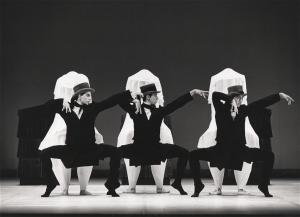The Fascination of Bee-keeping (1992)
Duration: 10’
For synth lute and pre-recorded track
Vocals: Rachel Lopez de la Nieta
Choreography: Michael Keegan-Dolan
Lighting: Sebastian Petit
First performed at the Woodville Hall, Gravesend as part of the 1992 Ballet Central National Tour.
Michael Keegan-Dolan’s first professional piece for Ballet Central provided further evidence of his capacity to create memorable images with this gothic tale of an urchin’s brush with beekeepers and disreputable undertakers.
Musically the tale is told through a mediaeval-style ballad, sung by dancer and choreographer, Rachel Lopez de la Nieta, and supported by a choir made up of some of the 2nd and 3rd year girls from Central School of Ballet, christened ‘the Bee Choir’ for the project. The words for the song were sourced from the early mediaeval Latin poet, Prudentius; using the Latin gave a strong sense of the neo-Gothic, the likelihood being that few would understand it, allowing the illusion to persist that the words are central to the drama, that it is in some way the story that is being narrated. Feeney was to later employ the same technique powerfully in the Blood Litany at the end of his full-length ballet, Dracula, four years later. In that case the language was the Latinate Romanian, more closely akin and deadly appropriate to the Transylvanian location of the story.
The doxology that concludes both choir sections was a direct borrowing from a previous motet written by the composer for his mother’s church, St. Swithun of Martyr Worthy, Hampshire. The motet for choir, organ and a set of crotales, played by a talented young local ten year old, spoke of the life and deeds of St. Swithun. For Ballet Central, the doxology was both speeded up, and a tricky 5/8 bar was added, to create more forward momentum.
The track was created using a Roland D 550 and an Akai S950 together with cello provided by Caroline Smart, with the live element being supplied by a synthesized lute sound. The ricochet jeté effect characteristic of early string sounds that dominates the first part of the piece is in fact an inbuilt D550 patch with a delay. As has been suggested, it is a convincing representation of a non-vibrato violin played rather poorly!
photos by Bill Cooper


